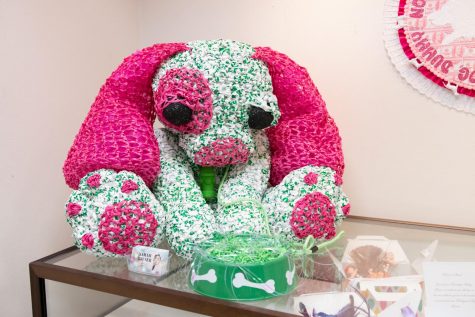Columbia community and professional artists create ‘bad art’ for showcase
October 27, 2021
Decorated pairs of underpants hang from wire hangers on the second floor of the Columbia College Chicago Library. The head-turning art piece is titled “Skidmarks” and features different symbols painted on each pair.
The piece, by Christopher Shoup, is part of the exhibit, “Bad Art: Kitsch, Camp and Craft,” currently on display at the library, 624 S. Michigan Ave.
“There are some things that have over time become synonymous as either kitschy or camp, or low art,” said Kristy Bowen, Columbia library’s access services assistant and the Bad Art exhibit programmer. “Black velvet paintings, for example, stuck to the wall in your basement have worth. It is really just a technique that could be used in many ways, in a more serious sort of art sense.”
The exhibit includes art made of recycled materials, religious art and other pieces pushing the boundaries of what is determined to be good or bad art.
Jerry Bleem’s untitled work features multiple statues of Jesus in traditional clothing positioned in rows on graduated risers making them look like a choir. The Jesus statues were found in various Chicago churches.

“One of the things that we’re talking about in this exhibit is that those distinctions [between high and low art] seem to be completely arbitrary and perhaps made with biased interpretations,” Bowen said.
Bowen said technology and the internet are closing the divide between elites and non-elites.
“Twenty years before the internet, the only way that you could show your work would have been a gallery … or do a zine, but it would have gone through a distributor,” Bowen said. “Now you can sell your artwork or your zine directly online.”
Art submissions for the exhibit were from staff, one student — Anna Bachmann — and professional, Chicago-based artists. The exhibit opened on Oct. 15 and runs through Jan. 15, 2022.
The exhibit is part of the Columbia Aesthetics of Research program series, which was founded in 2014 by co-creators Bowen and Jennifer Sauzer, head of Access Services and Assessment in the library. Both Bowen and Sauzer curated the Bad Art exhibit.

“I think that show at the library is using the term ‘bad art’ ironically, and with a little bit of humor,” said Debra Riley Parr, associate professor in the Art and Art History Department. “And so with that being said, of course, art history folks and art critics have been judging art for a long time.”
Parr said craft, a form of “low art,” is differentiated from “high art” because it differs from an aesthetic based on artistic expertise and education. As a way of understanding issues of equity, Parr said craft contains a rebellious, partisan component.
“My students always love to point out artist Jeff Koons,” Parr said. “He’s considered a high-end artist but traffics in a lot of those ideas about popular culture.”
Dissimilar standards of definition are an issue, but they are parts of a graduated exploration that is beneficial to understand, Sauzer said. Still, the options in less organized forms of art like camp, craft and black velvet painting have fewer gatekeepers, which allows a celebratory, less rigid artistic experience.
Fine art, most often, is created by artists with pedigreed educations that not everyone has access to.

Rachel Balter, an exhibitor, professional graphic designer and illustrator, said the distinction between low and high art has functioned as a symbol of class divide because low-brow art is made by and for non-elites, labeling them and the art they create as unimportant.
Sauzer said both high and low forms of art are separate wavelengths, but there are fewer roadblocks to exhibition for low art, which can be displayed in less formal places.
“High and low art are both of value, and I see them as different channels,” Sauzer said. “The high channel comes with a lot of money. It’s just a different scene. … I think this show [Bad Art] is about celebrating those other channels, not so much focusing on the differences.”







